Fixing John Ruth's Cracked
Hewing Axe
Return to georgesbasement
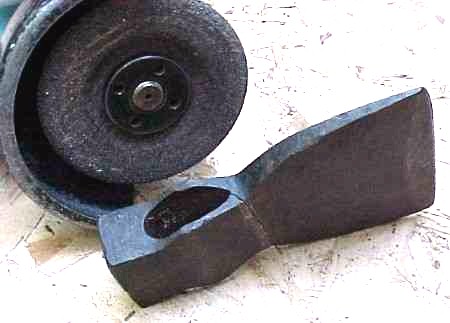 Before
the start, there was this pathetic, cracked fifty-cent hewing axe that
was suffering some sort of sad birth defect. The axe seems never to have
been used, and may have cracked when the handle was first wedged or when
the handle swelled ... Porch dwellers will have to suffer that tailed demon
in the background.
Before
the start, there was this pathetic, cracked fifty-cent hewing axe that
was suffering some sort of sad birth defect. The axe seems never to have
been used, and may have cracked when the handle was first wedged or when
the handle swelled ... Porch dwellers will have to suffer that tailed demon
in the background.
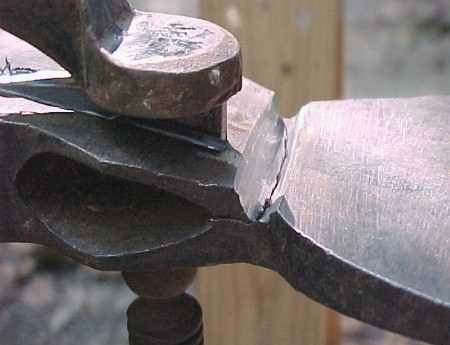 The first
step was to Vee out the crack as deeply as possible without opening up
the root (which would have necessitated using a backing plate of some sort).
The "C" clamp forced the crack closed. The grinding wheel was
the "soft" variety, chosen because its coarse abrasive grains
cut freely without getting dull. The dull ones break off easily, exposing
fresh, sharp ones. That's what's "soft" about it.
The first
step was to Vee out the crack as deeply as possible without opening up
the root (which would have necessitated using a backing plate of some sort).
The "C" clamp forced the crack closed. The grinding wheel was
the "soft" variety, chosen because its coarse abrasive grains
cut freely without getting dull. The dull ones break off easily, exposing
fresh, sharp ones. That's what's "soft" about it.
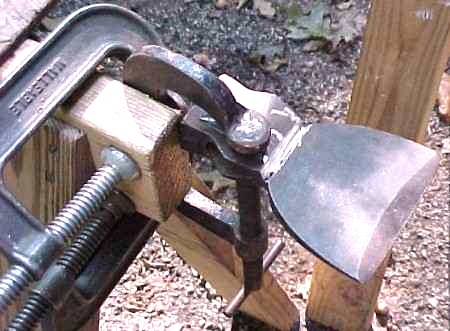 Here's
the welding setup, with the two "C" clamps at left holding the
third one that is clamping the crack. Oh, yes; preheat was a necessity
because of the uncertain carbon content of this part of the body of the
axe. We don't want the weld to crack, now do we ? Preheating was done with
a small propane torch, raising the axe's overall temperature to about 300
degrees Fahrenheit. The high-carbon steel (if that is what it is, next
to the eye of the axe) would otherwise likely form hard martensite after
the weld cooled because of the sudden welding heat input and subsequent
rapid heat flow into the cooler parts of the metal. Preheating slows down
the internal heat transfer rate by reducing the temperature gradient. It
also tempers any martensite that does form.
Here's
the welding setup, with the two "C" clamps at left holding the
third one that is clamping the crack. Oh, yes; preheat was a necessity
because of the uncertain carbon content of this part of the body of the
axe. We don't want the weld to crack, now do we ? Preheating was done with
a small propane torch, raising the axe's overall temperature to about 300
degrees Fahrenheit. The high-carbon steel (if that is what it is, next
to the eye of the axe) would otherwise likely form hard martensite after
the weld cooled because of the sudden welding heat input and subsequent
rapid heat flow into the cooler parts of the metal. Preheating slows down
the internal heat transfer rate by reducing the temperature gradient. It
also tempers any martensite that does form.
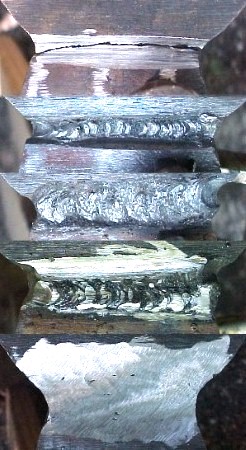 To
make a long story short, here's the progress of the welding, starting at
the top of the montage and working down to the finished and re-contoured
weld, blended with the virgin metal on each side. I'm not showing every
single step, by the way. I did grind the weld back to sound metal after
each pass to minimize the embedment of slag and the burying of lack-of-fusion
defects. The general procedure was DC, straight polarity arc welding with
3/32 inch electrodes of the 7011 variety. The current was in the normal
range for this size electrode. On bigger stuff I use more than the normal
current and the arc splatters quite a bit more. These weld passes didn't
do that, so there was little weld spatter to knock off the virgin metal.
The soft 7011 filler metal assures that the weld metal at least will stay
soft. The passes were executed in fairly quick succession with breaks mostly
for taking these pictures, so the axe stayed well over boiling water temperature
the whole time, and there were no hard zones apparent in the grinding marks
afterwards. Whew. I used multiple passes for two reasons: The electrical
circuit won't take any more; and I'm not dextrous enough to execute the
whole thing in one "go." Oh yeah; it also produces a better weld
with less effective heat input and reduced distortion.
To
make a long story short, here's the progress of the welding, starting at
the top of the montage and working down to the finished and re-contoured
weld, blended with the virgin metal on each side. I'm not showing every
single step, by the way. I did grind the weld back to sound metal after
each pass to minimize the embedment of slag and the burying of lack-of-fusion
defects. The general procedure was DC, straight polarity arc welding with
3/32 inch electrodes of the 7011 variety. The current was in the normal
range for this size electrode. On bigger stuff I use more than the normal
current and the arc splatters quite a bit more. These weld passes didn't
do that, so there was little weld spatter to knock off the virgin metal.
The soft 7011 filler metal assures that the weld metal at least will stay
soft. The passes were executed in fairly quick succession with breaks mostly
for taking these pictures, so the axe stayed well over boiling water temperature
the whole time, and there were no hard zones apparent in the grinding marks
afterwards. Whew. I used multiple passes for two reasons: The electrical
circuit won't take any more; and I'm not dextrous enough to execute the
whole thing in one "go." Oh yeah; it also produces a better weld
with less effective heat input and reduced distortion.
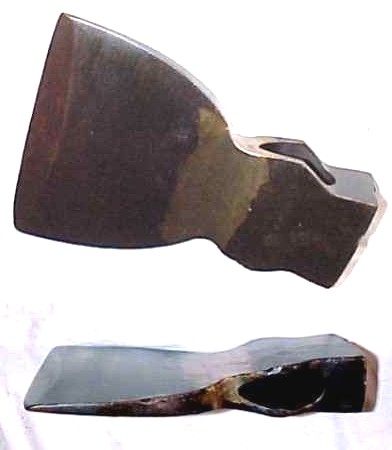 Here's
the finished product, shown here coated with tung oil and heated in the
oven several hours at around 400 Fahrenheit. That served two purposes.
Firstly, it tempered any hard metal that might have formed in the last
welding pass; and Secondly, it turned the freshly ground surface a nice
bronze color. The bronze color was partly due to darkening of the tung
oil and partly temper color from the oxide formed underneath the polymerized
tung oil. The later welding passes would have caused the hard metal formed
in the first few passes to be tempered, so it was only the last pass that
needed attention. The ends of the weld (the corners near the eye at each
end of the weld) were most demanding of technique; I adjusted by reducing
the welding current for these corners, which allowed metal to build up
past the general contour of the metal so that I could then shape it by
grinding.
Here's
the finished product, shown here coated with tung oil and heated in the
oven several hours at around 400 Fahrenheit. That served two purposes.
Firstly, it tempered any hard metal that might have formed in the last
welding pass; and Secondly, it turned the freshly ground surface a nice
bronze color. The bronze color was partly due to darkening of the tung
oil and partly temper color from the oxide formed underneath the polymerized
tung oil. The later welding passes would have caused the hard metal formed
in the first few passes to be tempered, so it was only the last pass that
needed attention. The ends of the weld (the corners near the eye at each
end of the weld) were most demanding of technique; I adjusted by reducing
the welding current for these corners, which allowed metal to build up
past the general contour of the metal so that I could then shape it by
grinding.
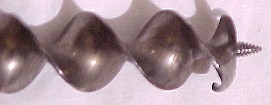 "What
wuzzinit for the welder ?" you ask. Waaal; an oversized No.14 Cook's
Patent auger bit, bringing me ever so close to a full set of those little
fellas. Cook was the guy who patented a clever form of cutting edge for
boring tools about a week before Russell Jennings got his famous patent
for another form of auger bit. Oh, well. Cook's patent is memorable because
he describes the process of making the bit in about two paragraphs; the
patent document is only two pages long, including figures.
"What
wuzzinit for the welder ?" you ask. Waaal; an oversized No.14 Cook's
Patent auger bit, bringing me ever so close to a full set of those little
fellas. Cook was the guy who patented a clever form of cutting edge for
boring tools about a week before Russell Jennings got his famous patent
for another form of auger bit. Oh, well. Cook's patent is memorable because
he describes the process of making the bit in about two paragraphs; the
patent document is only two pages long, including figures.
Go back to top of page
 Before
the start, there was this pathetic, cracked fifty-cent hewing axe that
was suffering some sort of sad birth defect. The axe seems never to have
been used, and may have cracked when the handle was first wedged or when
the handle swelled ... Porch dwellers will have to suffer that tailed demon
in the background.
Before
the start, there was this pathetic, cracked fifty-cent hewing axe that
was suffering some sort of sad birth defect. The axe seems never to have
been used, and may have cracked when the handle was first wedged or when
the handle swelled ... Porch dwellers will have to suffer that tailed demon
in the background. The first
step was to Vee out the crack as deeply as possible without opening up
the root (which would have necessitated using a backing plate of some sort).
The "C" clamp forced the crack closed. The grinding wheel was
the "soft" variety, chosen because its coarse abrasive grains
cut freely without getting dull. The dull ones break off easily, exposing
fresh, sharp ones. That's what's "soft" about it.
The first
step was to Vee out the crack as deeply as possible without opening up
the root (which would have necessitated using a backing plate of some sort).
The "C" clamp forced the crack closed. The grinding wheel was
the "soft" variety, chosen because its coarse abrasive grains
cut freely without getting dull. The dull ones break off easily, exposing
fresh, sharp ones. That's what's "soft" about it. Here's
the welding setup, with the two "C" clamps at left holding the
third one that is clamping the crack. Oh, yes; preheat was a necessity
because of the uncertain carbon content of this part of the body of the
axe. We don't want the weld to crack, now do we ? Preheating was done with
a small propane torch, raising the axe's overall temperature to about 300
degrees Fahrenheit. The high-carbon steel (if that is what it is, next
to the eye of the axe) would otherwise likely form hard martensite after
the weld cooled because of the sudden welding heat input and subsequent
rapid heat flow into the cooler parts of the metal. Preheating slows down
the internal heat transfer rate by reducing the temperature gradient. It
also tempers any martensite that does form.
Here's
the welding setup, with the two "C" clamps at left holding the
third one that is clamping the crack. Oh, yes; preheat was a necessity
because of the uncertain carbon content of this part of the body of the
axe. We don't want the weld to crack, now do we ? Preheating was done with
a small propane torch, raising the axe's overall temperature to about 300
degrees Fahrenheit. The high-carbon steel (if that is what it is, next
to the eye of the axe) would otherwise likely form hard martensite after
the weld cooled because of the sudden welding heat input and subsequent
rapid heat flow into the cooler parts of the metal. Preheating slows down
the internal heat transfer rate by reducing the temperature gradient. It
also tempers any martensite that does form. To
make a long story short, here's the progress of the welding, starting at
the top of the montage and working down to the finished and re-contoured
weld, blended with the virgin metal on each side. I'm not showing every
single step, by the way. I did grind the weld back to sound metal after
each pass to minimize the embedment of slag and the burying of lack-of-fusion
defects. The general procedure was DC, straight polarity arc welding with
3/32 inch electrodes of the 7011 variety. The current was in the normal
range for this size electrode. On bigger stuff I use more than the normal
current and the arc splatters quite a bit more. These weld passes didn't
do that, so there was little weld spatter to knock off the virgin metal.
The soft 7011 filler metal assures that the weld metal at least will stay
soft. The passes were executed in fairly quick succession with breaks mostly
for taking these pictures, so the axe stayed well over boiling water temperature
the whole time, and there were no hard zones apparent in the grinding marks
afterwards. Whew. I used multiple passes for two reasons: The electrical
circuit won't take any more; and I'm not dextrous enough to execute the
whole thing in one "go." Oh yeah; it also produces a better weld
with less effective heat input and reduced distortion.
To
make a long story short, here's the progress of the welding, starting at
the top of the montage and working down to the finished and re-contoured
weld, blended with the virgin metal on each side. I'm not showing every
single step, by the way. I did grind the weld back to sound metal after
each pass to minimize the embedment of slag and the burying of lack-of-fusion
defects. The general procedure was DC, straight polarity arc welding with
3/32 inch electrodes of the 7011 variety. The current was in the normal
range for this size electrode. On bigger stuff I use more than the normal
current and the arc splatters quite a bit more. These weld passes didn't
do that, so there was little weld spatter to knock off the virgin metal.
The soft 7011 filler metal assures that the weld metal at least will stay
soft. The passes were executed in fairly quick succession with breaks mostly
for taking these pictures, so the axe stayed well over boiling water temperature
the whole time, and there were no hard zones apparent in the grinding marks
afterwards. Whew. I used multiple passes for two reasons: The electrical
circuit won't take any more; and I'm not dextrous enough to execute the
whole thing in one "go." Oh yeah; it also produces a better weld
with less effective heat input and reduced distortion. Here's
the finished product, shown here coated with tung oil and heated in the
oven several hours at around 400 Fahrenheit. That served two purposes.
Firstly, it tempered any hard metal that might have formed in the last
welding pass; and Secondly, it turned the freshly ground surface a nice
bronze color. The bronze color was partly due to darkening of the tung
oil and partly temper color from the oxide formed underneath the polymerized
tung oil. The later welding passes would have caused the hard metal formed
in the first few passes to be tempered, so it was only the last pass that
needed attention. The ends of the weld (the corners near the eye at each
end of the weld) were most demanding of technique; I adjusted by reducing
the welding current for these corners, which allowed metal to build up
past the general contour of the metal so that I could then shape it by
grinding.
Here's
the finished product, shown here coated with tung oil and heated in the
oven several hours at around 400 Fahrenheit. That served two purposes.
Firstly, it tempered any hard metal that might have formed in the last
welding pass; and Secondly, it turned the freshly ground surface a nice
bronze color. The bronze color was partly due to darkening of the tung
oil and partly temper color from the oxide formed underneath the polymerized
tung oil. The later welding passes would have caused the hard metal formed
in the first few passes to be tempered, so it was only the last pass that
needed attention. The ends of the weld (the corners near the eye at each
end of the weld) were most demanding of technique; I adjusted by reducing
the welding current for these corners, which allowed metal to build up
past the general contour of the metal so that I could then shape it by
grinding. "What
wuzzinit for the welder ?" you ask. Waaal; an oversized No.14 Cook's
Patent auger bit, bringing me ever so close to a full set of those little
fellas. Cook was the guy who patented a clever form of cutting edge for
boring tools about a week before Russell Jennings got his famous patent
for another form of auger bit. Oh, well. Cook's patent is memorable because
he describes the process of making the bit in about two paragraphs; the
patent document is only two pages long, including figures.
"What
wuzzinit for the welder ?" you ask. Waaal; an oversized No.14 Cook's
Patent auger bit, bringing me ever so close to a full set of those little
fellas. Cook was the guy who patented a clever form of cutting edge for
boring tools about a week before Russell Jennings got his famous patent
for another form of auger bit. Oh, well. Cook's patent is memorable because
he describes the process of making the bit in about two paragraphs; the
patent document is only two pages long, including figures.